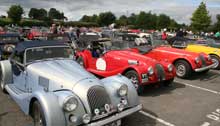Morgan's Birthday Bash
Few automakers are celebrating these days. General Motors virtually ignored the corporate the corporate centenary in 2008, and not a whimper has been heard of a 75th anniversary observance for Chrysler, be it Corporation or LLC. Ironically, the biggest bash has been reserved for what might be the least of them: the Morgan Motor Company of Malvern Link, Worcestershire, England.
It is fitting that Morgan should celebrate, not only the company's survival under family management but also its status as the last vestige of the indiginous British motor industry. To that end, the company and the several Morgan clubs mounted a huge centenary celebration comprising more than a week of activities. In addition to the church service held in the Morgans' home village of Stoke Lacy, Jill and I attended the final event, a convocation of thousands of Morgans at Cheltenham Race Course on Sunday, August 2nd.
Throughout the morning Morgans queued for entry, and by early afternoon there were Morgans as far as the eye could see. They came from nearby France and Belgium, from Norway, Austria and Spain. They came across the seas from Canada, British Columbia, in fact, and from Victoria in Australia. Satoru Araki, of the Morgan Enthusiasts Club Japan, brought his Morgan home to Britain for the first time in 30 years.
Perhaps most interesting were the three-wheel Morgans on display. Their owners are some of the least pretentious of enthusiasts, their cars lovingly preserved, not restored, and frequently driven. This 1924 Standard Popular, owned by Brian Betts, is considered a National Treasure, never restored but simply "sympathetically maintained." Other venerable three-wheelers included an Aero model, Ford-engine F-Type and a nifty little van.
Of particular note was the one-off Plus 4 saloon, built by Cooper Bodies of London in 1952. There were also two examples of the much-maligned Plus 4 Plus, the late Peter Morgan's unsuccessful 1960s attempt at updated Morgan styling. Poorly received by purists, just 26 of the fiberglass bodies were built before a fire destroyed the molds. Considering the current Aeromax coupe, it just may have been a car ahead of its time.
The Morgan Motor Company had a showroom tent with current models and other concepts, including a replica of the original 1909 prototype, a fuel cell LIFEcar, a bright orange Aeromax and some toy three-wheelers. Outside were some significant Morgans like Peter Morgan's Plus 8 AB16, and his late wife's Plus 8 convertible coupe, the only such model and probably the only Morgan with an automatic transmission.
Specialty Morgans included one in German police colors (but right-hand drive and with British registration) and a "Morgan" golf car. Concours judging had taken place on Saturday, and winning cars were proudly wearing their ribbons.
Throughout the day, enthusiasts were competing in AutoSolo events, a British form of Autocross, while family members had the option of amusement rides, slot car racing (with Morgan slot cars, of course) and various types of music. Clowns on stilts and riding bicycles wandered through the grounds and the obligatory steam traction engine did its thing. One could purchase Morgan art work, or meet and join some of the Morgan clubs. Some folks, however, were content just to picnic among all the Morgans.
We left before the evening entertainments, which included the English Symphony Orchestra, but counted the day a success. Not only had we seen thousands of Morgans, including many rare ones, but I had figured out why the Aero 8 design has finally grown on me. The first models had an unattractive cross-eyed look. With a new headlamp design, the strabismus has been largely corrected.

